Some animals have vernacular names that make you wonder where they come from. In the Netherlands many animal names have been coined in the past two centuries. A lot of species don’t even have a Dutch name and some only have one since the last decades of the last century. This is the case with some dragonfly and damselfly species, but also with many moths. A large number of the Dutch animal names however, originate in times long past. For example, the Dutch name for thrush ‘lijster’ dates back to at least the period around 1300 and the Dutch name for gull ‘meeuw’ was already used in 1287. The Dutch name for a blackbird ‘merel’ is even older, from the first half of the 13th century. The animal I’m talking about in this blog has a name that is much older and goes back to the Germanic language that was spoken in the first centuries at the beginning of our era.
Bird of the goddess
At that time many gods were worshiped. From the elementary school history lesson you may remember Wotan, the supreme god, and Donar, the thunder god. And Freyja, the goddess of love and fertility. The protagonist of this blog, the ladybird, was called Freyafugle by the Germanic people, which means as much as bird of the goddess Freyja. The Germanics saw the ladybird as a harbinger of spring and thus the dawn of the fertile season. But then came the period when Christianity began its expansion drive. The worshipping of more than one god was, of course, out of the question, and during Christianisation – the conversion of these non-Christian peoples – everything had to give way that reminded at all of that pagan worship of more than one god. Likewise the name Freyafugle, which had to make way for a more Christian variant and that became the ladybird. The lady in its name refers to the virgin Mary, similar to its German name Mariënkafer (the beetle of Mary). In the United States they are referred to as the ladybug. The French have not yet decided who should be honored, because in addition to the common name coccinelle, they also use the names bête de bon Dieu (animal of the good Lord) or bête de la Vierge (animal of the virgin). In Dutch it’s called lieveheersbeestje which is similar to the French bête de bon Dieu.
Lost forewings
The ladybird belongs to the order of the beetles (Coleoptera). An important characteristic of this insect family is the elytron, or rather the elytra because there are two of them. The ancestors of the beetles, just like dragonflies and butterflies, had two pairs of wings. Over many millennia, the forewings evolved into hard elytra. The delicate rear wings have remained intact and are hidden under this sturdy armour when at rest. If you look at a ladybird up close, you will see that the animal can also hide its legs and antennae under this armour. The colour of the elytra of ladybirds is often red or orange and often provided with dots. Some people claim that the number of dots is the age of the animal. This can immediately be referred to the realm of fiction, because the number of dots has nothing to do with its age.
Around sixty species
The number of dots has everything to do with the species. There is not just one kind of ladybird, around are about 5000 species that occur all over the world, of which around 750 in Europe and around 60 in the Netherlands and Belgium. On this poster of the Dutch foundation EIS Knowledge Center of Insects 43 of them are shown. Many of these species have received both a scientific and Dutch name that has a relationship with the number of dots. This number is therefore an important tool for determining. One of the common species and perhaps most famous is the seven-spot ladybird (Coccinella septempunctata). The species name Septempunctata comes from the Latin ‘septem’ that means seven and ‘punctata’ that means dotted. There is also a kind of twenty-four dots, and you may guess its name: 24-spot ladybird (Subcoccinella vigintiquatuorpunctata). Viginti quattuor is Latin for twenty-four. And there are more ladybird names referring to the number of dots. Now that’s easy, right?
Multicoloured
This is generally easy to apply with most ladybirds. But there are also types of ladybirds that have no dots at all and within some species there is also a lot of variation and there may be individuals with and without dots. And the dots do not necessarily have to be black. Just look at the orange ladybird (Halyzia sedecimguttata), which is – of course – orange in colour, but with creamy spots. There are also ladybirds with more spotty patterns instead of clear dots. An example of this is the 14-spotted ladybird beetle (Propylea quatuordecognuctata). This has light spots on a black surface, sometimes the light spots dominates so it seems rather black spots on a light surface.
Deukje op de rug
A very special species in terms of colours is the harlequin ladybird (Harmonia axyridis), also known as multicoloured Asian ladybird. This name is explained by the various combinations of orange-red with black individuals of this species can display. Sometimes they are black with two or four orange-red stains, which we call the colour variant conspicua and spectabilis, respectively. Sometimes the base colour is orange-red with a multitude of black dots, ranging from zero to nineteen. This variation to colour and number of dots makes it a tricky species to determine. However, there are two important characteristics in which this ladybird distinguishes itself from the other species. First of all the black ‘M’-shaped drawing on the pronotum (that is the light-coloured portion between the back shield and the head). This is not visible in some colour variants, see the photos below. In addition, the Asian ladybird often has a dent or pleat at the back of the elytra.
Plague of aphids
Most ladybirds eat larvae and aphids. There are also some vegetarian species, such as the aforementioned orange ladybird that lives from mildew (that is a kind of mealy layer on leaves that is created by certain fungi). Because of their preference for aphids, ladybirds are welcomed in gardens and orchards alike. Aphids suck plant sap and can cause damage to plants through the transfer of viruses and diseases. They may therefore become a true plague. To combat this in a biologically responsible manner, ladybirds are used. Perhaps our native ladybirds were too fast to be saturated at a given moment or perhaps too picky, so they ate too few aphids. So around the turn of the century ladybirds were imported from Northeast Asia to be deployed to be used in horticulture and orchards.
From plague controller to plague insect
These Asian ladybirds liked the aphids and went to work enthusiastically. When the original crops no longer yielded enough aphids they showed a different side. They turned out to be a true predator that not only eats aphids but also feeds on the eggs, larvae and cocoons of the native ladybirds, among other things. It doesn’t stop there, because the adult native ladybirds were being eaten too. Moreover, the Asian ladybirds was found to even feed on ripe fruit! This again yields large damages to the gardeners or farmers. Add to that – in contrast to what one thought in advance – the Asian ladybird can certainly survive our European winters and doesn’t have many natural enemies here. Add the rapid reproduction cycle with several generations per year with enormous population growth as a result. So in the end, the agent is worse than the ailment, the plague controller has itself become a plague.
Sources (in Dutch):
This item was originally published in Dutch on March 7th 2021.



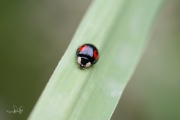
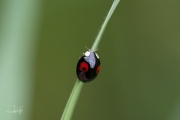
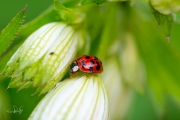
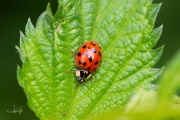
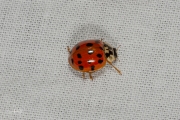
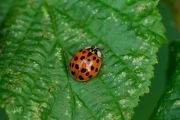
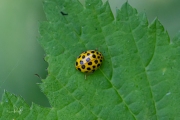
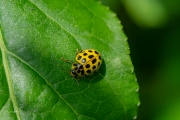
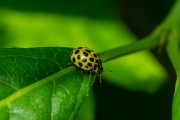
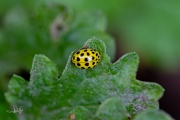
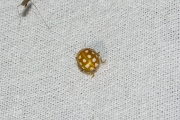
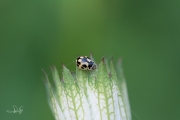
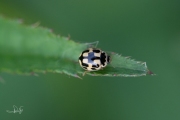
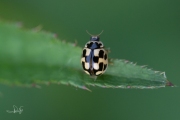
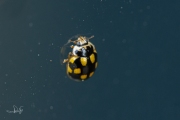
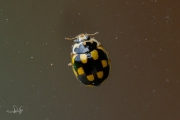
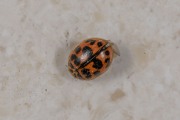
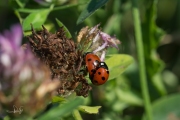
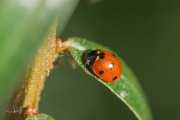
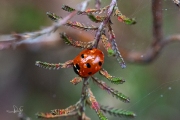
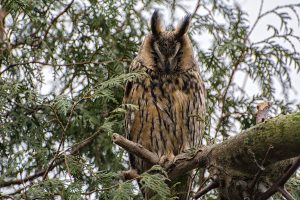
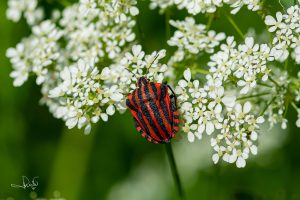

Thank you for your beautiful story about the ladybird/ bête de bon Dieu 😊
IT looks like the feminiene is bigger than the masculien ( on your photo of the coccinella septempunctata).
You’re welcome Hanneke! The female ladybird is indeed bigger, that happens more often in the animal world.